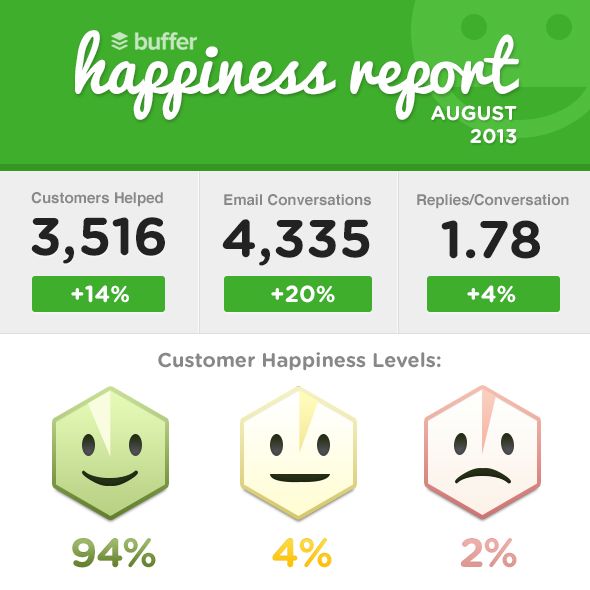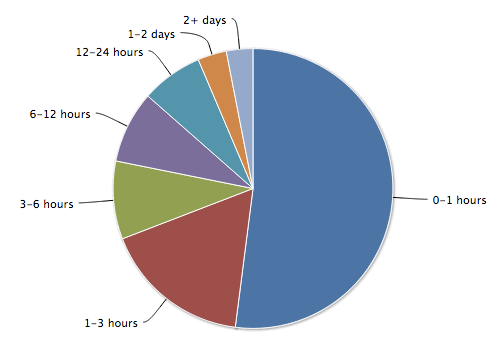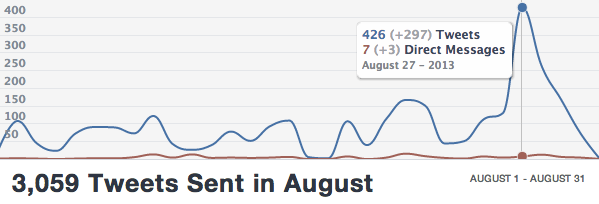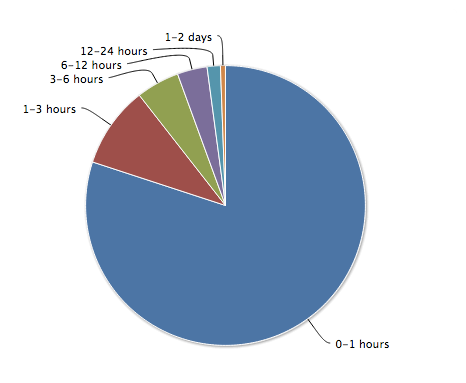How we reply to 52% of support emails within an hour: The August Buffer Happiness Report

Chief of Staff @ Buffer
At Buffer, we try to be transparent about everything, and our customer support processes and successes (and failures!) are no different. Here’s a snapshot of how we did in August.
August was a unique month at Buffer, because it began with the first-ever all-hands company retreat. Although this provided a unique challenge for the support team, it was absolutely amazing to have all of the full-time staff together. More on that in a bit. :)
In August, we chose to focus on one key metric: response time. We hypothesized that a faster reply would translate into happier customers. In order to accomplish this, we adjusted the division of labor to better reflect our energy levels throughout the day in our respective time zones.
Old method: No organized approach. Generally, everyone worked from oldest to newest.
New method: In order to better “manage our energy,” now we start our days with the older, ongoing and more involved conversations. By the end of the day, when we’re less fresh, we focus on answering simple questions as they come in. That way, the trickier ones that need developer help are flagged appropriately, and we can still delight the folks who just need a quick, simple answer. Let’s see how we did.
How we did in August

Speed:
Our response time, according to Help Scout:
Percentage of emails that got a reply under 1 hour: 52%
Percentage of emails that got a reply under 6 hours: 78%

Verdict: We did improve our speed! Unfortunately, this didn’t translate into an increase in self-declared customer happiness this time.
New: Twitter stats
The service we use to reply to support questions via Twitter, TwitSpark, now shows us how many customers we’re responding to! We sent 3,059 Tweets in August. Here’s a visual of our volume this month. That spike you can see was our Google+ Pages launch.

New support channels we’ve been experimenting with:
BMR has recently started replying to Google Play Store reviews that contain questions or product confusion related to our Android app. It’s hard to quantify the effects of this, but it feels right to be covering another customer touchpoint.
Also, we had our first ever “Buffer office hours” where I sat on a Google+ hangout for an hour and talked to anyone who dropped by. Three people joined. There’s nothing quite like looking customers in the eye and talking, so we’d like to try this again. The disorganized structure was fun and encouraged the casual feel we were looking for, but might not be conducive for a bigger crowd.
The impact of a product launch on support:
Lastly, we also had a big launch this month; we announced support for G+ pages in Buffer web, iPhone and Android. Interestingly, launch days usually pull our stats down because of the volume, but this launch (at 6am PST) was one of our best days yet, due to the whole Buffer team’s efforts:

The struggle of providing great support at the weekend:
How do we provide great support all week long (including weekends) without discouraging our team from disconnecting and taking time to renew?
Our time-zone spread helps with this, as the weekend only lasts from Friday evening in San Francisco to Monday morning in Europe (and soon Australia, which helps shorten the weekend even more). But, that’s still 24 hours where customers only get answers if Buffer staff suspend the weekend and dip in to answer a few questions here and there. Similarly, we felt this challenge when all Happiness Heroes found themselves in the United States, causing the weekend to extend to 2 full days. As Chase Clemons illustrates in his post, it can be tricky to have the whole team traveling at once!
We would love to hear how other support teams tackle this! :) And, as always, please reach out to us with any questions right here in the comments or at @buffer!
Try Buffer for free
180,000+ creators, small businesses, and marketers use Buffer to grow their audiences every month.
Related Articles

Note: This is the quarterly update sent to Buffer shareholders, with a bit of added information for context. We share these updates transparently as a part of our ‘default to transparency ’ value. See all of our revenue on our public revenue dashboard and see all of our reports and updates here . It's been quite the y

Editor’s Note: Thanks for checking out this post! We’ve released our updated 2021 pay analysis here. You can’t improve something if you don’t know that it needs to be improved. That was very true for us four years ago when we first started looking into equal pay at Buffer. We have long used a salary formula to determine all of our salaries – the same role in the same part of the world receives the same salary. That m

Ever since the world got turned upside down by COVID-19, it’s been “business as unusual” for everyone – Buffer included. I sent this update out to Buffer’s investors one week ago. I hesitated on whether to share it more widely, as I know a lot of companies have been impacted more severely in these times. That said, I believe it makes sense to lean into our company value of transparency, since there may be some companies this could help, and it shows Buffer customers that we will be around beyon